A fantasy football breakdown of the 2021 Buffalo Bills by high-stakes legend Shawn Childs
Coaching Staff
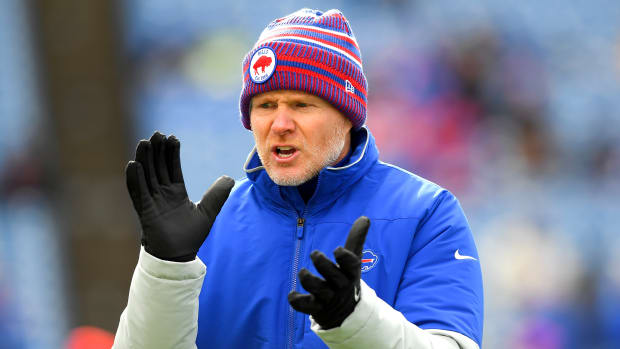
Over his four seasons as the head coach for Buffalo, Sean McDermott went 38-26 with three playoff appearances (2-3). The Bills made it to the AFC Championship Game last season (38-24 loss to the Chiefs), giving them their deepest postseason run since 1993.
Before 2017, McDermott worked as the defensive coordinator for the Panthers over six seasons, with his best success coming in 2013. Buffalo’s success last year dethroned the Patriots' 11-year run as the AFC East champs.
Brian Daboll will run the offensive for the fourth year. He’s been working in the NFL since 2000, with four other seasons of experience as an offensive coordinator (Cleveland, Miami, and Kansas City). Daboll worked in the Patriots’ coaching system for 11 seasons. In 2017, he was the offensive coordinator for the Crimson Tide that won the National Championship. He’s been part of five Super Bowl teams and one National College Championship.
More Buffalo Coverage: Bills CentralLast year Buffalo jumped to second in points scored (501) and second in offensive yards, which improved 187 points from 2019 (314) while gaining 22 spots in the offensive yards rankings.
Buffalo brought in Leslie Frazier to run their defense in 2017. He’s coached in the NFL since 1999, with 12 seasons coming as a defensive coordinator and three years as a head coach (21-32-1).
Unfortunately, the Bills’ defense didn’t come for the ride in 2020. They fell to 16th in points allowed (375 – 116 more than 2019) while ranking 14th in yards allowed (3rd in 2019 and 2nd in 2020).
Free Agency
The top five players signed in the offseason were LB Matt Milano, T Daryl Williams, WR Emmanuel Sanders, QB Mitchell Trubisky, and T Ty Nsekhe.
Milano and Williams were paid to be starters, and they should slide back into the starting lineup after playing in Buffalo in 2020. Milano missed six games last year after setting a career-high in tackles (101) in 2019 over 15 games. Williams led the Bills in snaps (1,237 last year while handling the right side of the offensive line.
Sanders is on the downside of his career (age 34) while expecting to work as a chain mover for the Bills. Buffalo added Jacob Hollister for depth at tight end. Trubisky brings a similar skill set to John Allen, but he has a lot to prove while failing to live up to his draft value (2nd overall in 2017) at this point in his career).
They released WR John Brown and DL Quinton Jefferson.
Draft Profiles
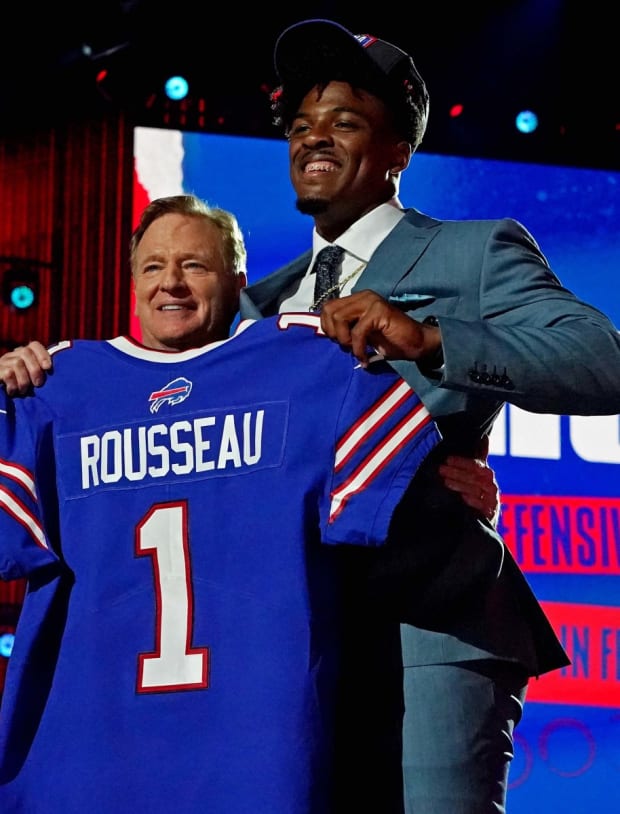
With their first two draft selections, Buffalo invested in their defensive line – DE Greg Rousseau (1.30) and DE Boogie Basham (2.29).
DE Greg Rousseau
Rousseau has the look of a disrupter in the pass rush, but he needs to get stronger to defeat more talented players in the NFL. His play has a bully feel, but Rousseau can be nullified by offensive linemen willing to counterpunch him with strength. His vision plays well while showing up on every play. Rousseau will have smaller gaps at the next level, which forced him to develop his moves to the quarterback. His speed and quickness should improve the Bills' edge rush defense.
More: Bills NFL Draft Tracker
DE Boogie Basham
Basham relies on more power than speed while almost having a stalemate feel at his position. His wins in the pass rush come from his ability to make wise decisions in his plan to attack the quarterback. He’ll have limited range vs. the run, but Basham does come to the field with a plan and the hands to create a winnable window in the pass rush.
Over the next two picks, Buffalo addressed their offensive line – Spencer Brown (3.30) and Tommy Doyle (5.17).
OT Spencer Brown
Brown is one of their rare value offensive linemen who has the talent to move from right tackle to left tackle with a high level of success once he improves his technique and adds more bulk. He’s worked hard to become a complete player while filling out into his massive frame. Brown shows value on the move with the arms and hands to keep defenders at a distance. His pass sets need refinement in his footwork while projecting to be an early upgrade in run blocking.
OL Tommy Doyle
Buffalo brought into Doyle’s war on the field as a run blocker. He plays an aggressive style, which will work against him in the NFL if Doyle doesn’t improve his discipline. His struggles come in pass protection, and the Bills may envision him as a guard where his shortfalls won’t be exposed as much.
The Bills finished their draft with three players in the sixth round: WR Marquez Stevenson, S Damar Hamlin, and CB Rachad Wildgoose. They finished with G Jack Anderson in the seventh.
WR Marquez Stevenson
Staying healthy has been a problem for Stevenson in his college career. He is an undersized receiver (5’10” and 180 lbs.). His ticket to the NFL comes from his speed and elusiveness. Stevenson will upgrade the return game for Buffalo while offering a mixed profile as a receiver. His route running isn’t at a level to earn starting or replacement snaps at this point in his career. He’ll struggle to defeat tight coverage in the deep passing game while lacking the movements or rhythm to win out of the slot. I only see a gimmick player while owning plenty of injury risk.
S Damar Hamlin
Hamlin lacks the man cover skill set to start for the Bills. His best play will come when moving forward toward the line of scrimmage, where his vision and play-making ability have more success. Wide receivers with speed will eat him up over the long field, but Hamlin has a chance to offer matchup value in the passing game in the red zone. He also comes with a checkered past with injuries.
CB Rachad Wildgoose
Buffalo wants to attack the quarterback while rostering cornerbacks to defend the short areas of the field out of press coverage. Wildgoose fits this mold, but his overall game shows weakness if asked to stay with his receiver too long. His speed isn’t fast enough to overcome a bad decision in technique or a missed step in chase mode.
G Jack Anderson
Anderson lacks the one tool that can easily be taught if he wants to start in the future in the NFL. His shortfall comes in patience and decision-making off the snap. Anderson’s aggressive style can turn into a massive mistake on some plays. He needs to have better vision and trust his technique out of his sets. His overall game should fit well for the Bills when they play from the lead and want to run the ball. Anderson shows quickness and the ability to pull while offering the fight to finish off his blocks in open space.
Offensive Line
The growth in the right arm of Josh Allen led to the Bills slipping to 20th in rushing yards (411/1,723) while scoring 16 touchdowns. They only had one run over 40 yards while gaining 4.2 yards per carry. The addition of Stefon Diggs worked wonders for the success of Buffalo’s passing game. They moved to third in passing yards (4,786) with 40 touchdowns and 11 interceptions. Their offensive line allowed 27 sacks (9th lowest), which was helped by Allen’s ability to run.
LT Dion Dawkins
Dawkins was a second-round draft pick by the Bills in 2017 after playing left tackle in his college career at Temple. He offers athletic ability and power to the tackle position, with his best asset expected to be pass protection. Dawkins started all 48 games over the past three seasons while playing the best ball of his career in 2020. He allowed minimal sacks and pressure on Allen while playing much better at run blocker.
LG Joe Feliciano
The Raiders drafted Feliciano in the fourth round in 2015, but he failed to earn a starting job over four seasons. In 2019 after signing with the Bills, he made 16 starts while finishing as a liability in all areas. His first appearance last year came in Week 9 after recovering from a pair of surgeries. Feliciano signed a three-year $17 million contract in mid-March, which puts him on track to start this season. He improved as a run blocker in 2020, but his skill set still shows weakness in pass protection.
C Mitch Morse
Over six seasons in the NFL, Morse has been a league-average player in all years in pass protection with minimal sacks allowed. He did allow more pressure in 2020, which may be a sign of decline in his game. His value in run blocking isn’t where it needs to be. Over the last two seasons, Moore has been flagged well over 10 times.
RG Cody Ford
After getting drafted in the second round in 2019, Ford made 15 starts, losing value across the board. After the season, he had right shoulder surgery while battling multiple injuries last year, leading to nine missed contests. His game is built on power while needing to add more strength and experience. Ford is still learning his position, and speed players do create problems for him. His best value should develop in the run game.
RT Daryl Williams
Williams played well in 2017 for the Panthers, but a right injury that required surgery cost him most of 2018. He struggled in pass protection in 12 starts the following season, leading to his release. He came into the league as a left tackle with better value as a run blocker. His play last season improved despite allowing too many sacks and taking many penalties.
Buffalo has a below-par offensive line, which is helped by a mobile quarterback who runs and avoids sacks. They added depth in this year’s draft class, pointing to more growth down the road.
Offense

Coming into 2020, the Bills averaged 473 runs over the previous three seasons while trying to have a balanced offense. Last year they scored early and often, which led to about a 40/60 split in running and passing.
Despite their success last year via the air, Buffalo only has one elite wide receiver (Stefon Diggs) this season. Their team structure says their 2020 success throwing the ball may not be repeatable. The Bills need to play better defensively while controlling the clock with the run game. Allen will get his chance to make plays downfield.
Quarterbacks
Josh Allen
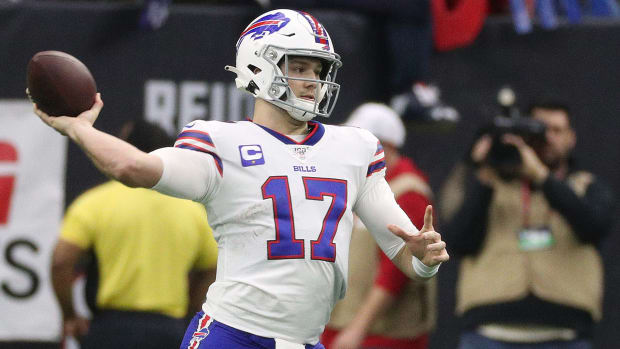
The best quarterback in the land last year was Allen. He finished with tremendous growth in his completion rate (69.2 – 58.8 in 2019) thanks to the excellent addition of Stefon Diggs (127/1,535/8) and his 76.5 percent catch rate. Allen gained 4,965 combined yards with an impressive 45 touchdowns. He gained over 300 yards in eight games, highlighted by two contests (434/4 and 429/4).
Over the past three seasons, he scored 25 rushing touchdowns in 40 games while gaining 1,562 yards on 300 attempts. Allen had eight runs over 20 yards in his rookie season, but only three over his last 211 carries. His yards per rush (4.1) regressed for the two straight years (7.1 in 2018 and 4.7 in 2019).
Fantasy owners will pay for Allen in 2021. He projects to be the second quarterback off the board behind Patrick Mahomes. His WR2 and WR3 come into the year at age 32 and 34. When adding in a career year for Diggs, Allen can only go backward in his success. I love his growth and ability to run, but the sum of his receiving core suggests that he is overpriced. I’ll set the early bar on 4,500 combined yards with a ceiling of 35 touchdowns.
Mitchell Trubisky
The Bears moved on from Trubisky after drafting him second overall in the 2017 NFL Draft. His career started with a 4-8 record in his rookie season. Over his last 38 starts, he went 25-13 while tossing 57 touchdowns with 30 interceptions. He ran for 1,057 yards, and eight touchdowns on 190 carries over four seasons of action. Trubisky has a winning record, and his style of plays is similar to Josh Allen while offering less explosiveness.
Jake Fromm
When doing some research on Fromm, my first thought was that he had a lot in common with Tom Brady.
Over three seasons at Georgia, Fromm went 36-7, highlighted by his play in his freshman season (13-2 with a loss in the national championship game). He passed for 8,236 yards over 43 games with 78 TDs and 18 Ints with no value as a runner (134/40/3). His passing total rose slightly every year (2,615, 2,761, 2,860) while playing in a run-heavy offense. Fromm had his best completion rate (67.4) and the highest number of touchdowns (30) in 2018.
Heading into this last year’s draft, his value took a hit due to a string of five straight games with weakness in his completion rate (44.8, 46.4, 47.8, 48.3, and 47.6) over his final six starts. On the positive side over this stretch, Fromm delivered five wins with 13 touchdowns and two Ints.
Other Options: Davis Webb
Running Backs

The Bills’ running back showed growth in their yards per rush (4.44) in 2020, but they received 51 fewer carries. They saw a decline as well in the passing game (55/421/2 on 78 targets).
Devin Singletary
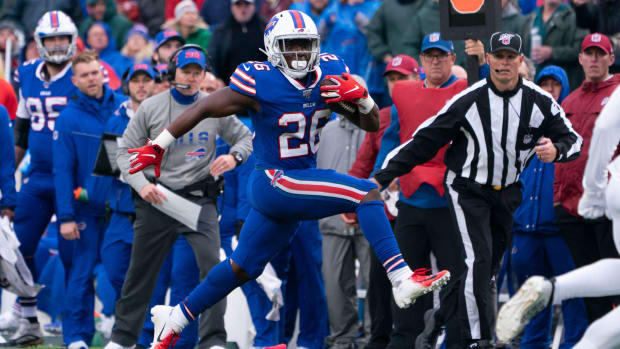
Based on his draft value (20th RB drafted), Singletary fell short of expectations. He gained 953 combined yards with two touchdowns and 38 catches while scoring 145.10 fantasy points (31st in PPR leagues).
Singletary gained over 75 yards rushing in one game. His top three fantasy outputs (16.10, 18.70, and 17.40) failed to reach an impact area. Buffalo gave him over 20 touches in two matchups. On his 194 touches in 2020, Singletary only had four plays over 20 yards.
Over his 28 career games, he averaged almost 69 yards with minimal damage in touchdowns (6). In the passing game, Singletary doesn’t project as a difference-maker (6.9 yards per catch).
Fantasy Outlook: At best, Singletary will receive 225 combined touches with a short number of scores. His ceiling in the passing game looks limited based on the usage by Josh Allen in his time with the Bills. His early ADP is 145 (48th running back), which is much more reasonable than last season. I only view him as a bye week or a short-term injury cover.
Zack Moss
Moss gained 576 combined yards with five touchdowns and 14 catches over 13 games in his rookie season. He missed three games early in the season with a toe injury and his season ended in the postseason due to a left ankle issue that required surgery. The Bills expect him to be ready for training camp.
His best game came in Week 8 (14/81/2) against the Patriots. Moss had four runs inside the 10-yard line in two different games, six chances coming over the last five yards before the end zone.
Moss flashed upside in 2017 when he gained 1,416 combined yards with ten TDs and 29 catches on 243 touches at Utah. The following season he shined again on early downs (179/1096/11) while losing value in the passing game (8/50/1). His season ended after nine games due to a right knee injury the required surgery. In 2019, Moss regained his previous form while delivering an outstanding season (1,804 combined yards with 17 TDs and 28 catches on 263 touches).
This season, he’ll work in a rotational role with goal-line value. Josh Allen remains the top scoring threat on the ground in close, which hurts Moss. Buffalo won’t give him enough chances in the passing game to warrant a starting role in the fantasy role.
Fantasy Outlook: He is a borderline RB3 in PPR leagues while needing an injury to Devin Singletary to receive a better opportunity. His next step should be 900-plus yards with five to seven touchdowns and about 25 catches.
Matt Breida
A trip to Miami didn’t work out well for Breida. The Dolphins only gave him 68 touches for 348 yards and nine catches. Over the previous two seasons with the 49ers, he averaged 5.2 yards per rush and 8.3 yards per catch, leading to 1,818 combined yards with seven touchdowns and 46 catches.
Fantasy Outlook: He brings big-play ability to the run game, which may be a problem for Devin Singletary if he starts slow. A sneaky handcuff in deeper leagues since he'll be in the mix if either Singletary or Moss are injured.
Other Options: Antonio Williams, Christian Wade, Taiwan Jones
Wide Receivers

From 2019 to 2020, Buffalo’s wide receivers caught 120 more passes for 1,486 yards and 13 touchdowns on 109 targets, which almost matched Stefon Diggs (127/1,535/8). The most significant growth area was the completion rate by Josh Allen to his wide receivers (53.2 in 2018, 64.2 in 2019, and 76.1 in 2020). The wide receiver position resulted in 81 percent of the Bills’ passing yards.
Stefon Diggs
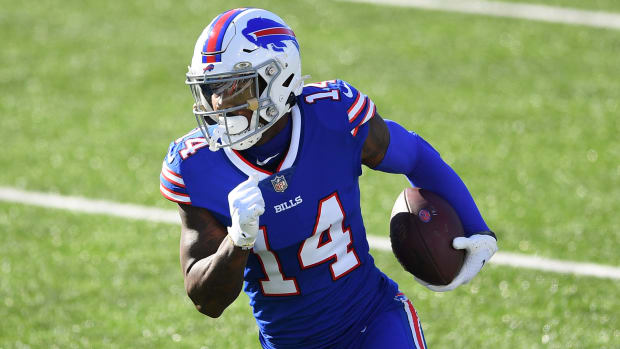
Over five seasons for the Vikings, Diggs caught 365 passes for 4,623 yards and 39 touchdowns on 534 targets, which works out to 5.2 catches for 66 yards and 0.56 touchdowns a game. Minnesota used him as a possession type over his first four years (11.6 yards per catch) before shining in the deep passing game in 2019 (17.9 YPC – eight catches over 40 yards).
With the Bills in 2020, Diggs turned into a beast. He caught 127 of his 166 targets (76.5 percent) for 1,535 yards and eight touchdowns. He finished with nine games over 100 yards (including the playoffs) while having a floor of six catches in 18 of his 19 starts. Diggs gained 12.1 yards per catch with 20 catches over 20 yards and eight over 40 yards.
The bottom line with Diggs is that he ran great routes and got open while catching almost everything thrown to him. He played an entire season for the first time in his career (10 missed games over 96 possible starts for the Vikings). His presence was the critical factor in the growth of Josh Allen. He finished as the 3rd highest scoring receiver in PPR leagues (20.54 FPPG) while drawing a second-round ADP (15) in the early draft season.
Fantasy Outlook: Diggs is a high floor player coming off a career year. His success looks repeatable, and Buffalo has a developing offense. I’m not a fan of the Bills’ secondary receivers, which should be a win for Diggs in 2021. My floor is about 110 catches for 1,300-plus yards, with a chance at 10 touchdowns.
Cole Beasley
At age 30 and 31 with Buffalo, Beasley had the best opportunity of his career (213 combined targets over 30 games). Last year he set career-highs in catches (82), receiving yards (976), and targets (107). Beasley has 25 catches over 20 yards for the Bills (15 in 2020) compared to 25 over his 103 games with Dallas.
Four of his five games with over 100 yards receiving came on the road (@Jets – 11/112, @ARI – 11/109/1, @SF – 9/130/1, and @DEN – 8/112). His catch rate (76.6) was slighter better than Stefon Diggs (76.5).
Beasley played through a leg injury in the postseason, which will be cleared up by the start of training camp.
Fantasy Outlook: His role and opportunity will be the same again this year, but Beasley turned 32 in late April. He works best as WR5 in PPR leagues while owning an early ADP of 146 in the early 12-team high-stakes market. In 2020, Beasley was the 27th highest scoring wide receiver (12.98 FPPG). He is an overlooked player who is getting better with age. A fair pre-draft evaluation would be 75 catches for 850 yards and five touchdowns.
Gabriel Davis
After getting drafted in the fourth round in 2020, Davis caught 35 of his 62 targets for 599 yards and seven touchdowns in his rookie season. He offered sneaky value in his eight home games (23/464/4 – 20.2 yards per catch) while fading on the road (16/220/3).
The addition of Davis adds size (6’2” and 215 lbs.) to the outside for Buffalo while still offering speed (4.54 forty at the NFL combine in 2020). His route running and release need work, along with a higher motor. Davis wins with his hands in tight battles and while high-pointing contested passes. His lack of quickness does hurt him in press coverage.
In his junior season at the University of Central Florida, Davis put himself on the NFL map after catches 72 of his 133 targets for 1,241 yards and 12 touchdowns. He improved in each season in college. Davis projects as a jump ball winner in the end zone, with his hands being his best assets.
The natural progression of Davis based on his play and success last year should make him the WR2 for the Bills by next season. His size and hands create scoring chances while almost owning a game-breaker feel. Last year he averaged 17.1 yards per catch with some weakness in his catch rate (56.5).
Fantasy Outlook: Davis almost has a breakout ADP (155) as the third Bills’ wide receiver drafted in the early draft season. His age (22) and upside make him a player to keep an eye on in Buffalo’s training camp this summer.
Emmanuel Sanders
Sanders will be playing for his fourth franchise over the past three seasons while starting the year at age 34. His career peaked from 2014 to 2016 for the Broncos (101/1,404/9, 76/1,135/6, and 79/1,032/5) under the guidance of Peyton Manning. The move to the Saints should have delivered a better season (61/726/5 on 82 targets over 14 games) when adding the injury-plagued season by Michael Thomas.
His only impact game (12/122) came at home in Week 5. Sanders was a better player at home (32/423/2) than on the road (29/303/3). He did finish with strength in his catch rate (74.4), which looks to be a good sign for the Bills’ passing game.
Fantasy Outlook: Buffalo lacks a top threat at tight end, which helps Sanders's ability to get targets. Last year Josh Allen threw 429 passes to his wide receivers, with 273 targets going to his top two options. He projects to be closer to 50 catches for 600 yards and a handful of touchdowns.
Other Options: Isaiah McKenzie, Marquez Stevenson, Isaiah Hodgins
Tight Ends

The direction of the targets for the Bills’ tight ends has gone down over the past two seasons. Josh Allen completed only 10 percent of his passes to tight ends in 2020, leading to 41 catches for 445 yards on 66 targets. Their most significant growth area came from scoring nine touchdowns (three in 2019 and one in 2018).
Dawson Knox
Last year Knox missed four of the Bills' first eight games while being a non-factor in six contests (2/26, 1/36, 2/16, 1/15, 0/0, and 2/16) over the first 10 weeks. Over the final nine games, including the playoffs, he caught 26 of 41 targets for 244 yards and five touchdowns. Knox only had one contest with over 50 yards receiving (3/41) and one other matchup with more than four catches (6/42/1).
Over two seasons, his catch rate (55.3) doesn’t project upside. He picked up 28 catches for 388 yards and two scores in his rookie season.
Fantasy Outlook: The way Knox finished last year, he looks to have a 50-catch opportunity for Buffalo if they start to throw more to the tight end position. At best, Knox is a bye week filler.
Jacob Hollister
After signing as an undrafted free agent in 2017 by the Patriots, Hollister found a playable home in 2019 and 2020 for the Seahawks. Over 27 games in Seattle, he caught 66 passes for 558 yards and six touchdowns on 99 targets. Russell Wilson used him as a dump-off option (8.5 yards per catch).
Fantasy Outlook: Hollister projects as the TE2 with a minimal opportunity when Knox is on the field.
Other Options: Tommy Sweeney, Nate Becker
Kicker
Tyler Bass
In his rookie season, Bass won the starting job for all 16 games. He made 28 of his 34 field goals (82.4 percent) while doing an excellent job from long range (8-for-9 from 40 to 49 yards and 4-for-6 from 50 yards or more. Bass missed two of his 59 extra-point tries. His success led to the fourth-highest scoring output (10.37 FPPG) for his position.
Fantasy Outlook: Over 13 games, including the postseason, he scored under eight fantasy points in two games. Bass scored 12.00 fantasy points or more in six matchups over this span. This year, he should be drafted as a top-six kicker.
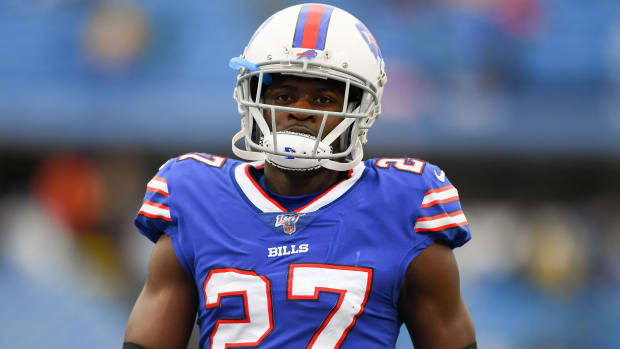
Defense
The Bills climbed to 17th in the NFL defending the run despite allowing more yards (1,914) than 2019 (1,649 yards). They allowed 4.6 yards per rush with massive struggles in rushing touchdowns allowed (21 – 27th). Buffalo didn’t give up a run over 40 yards.
They fell to 13th vs. the pass (232.9 yards per game). Buffalo allowed 6.9 yards per pass attempt with 23 passing touchdowns and 15 interceptions while picking up 38 sacks.
The Bills finished seventh in fantasy defense scoring (118.0 fantasy points) in the Fantasy Football World Championships.
CB Tre’Davious White
The fear of attacking White in coverage appears to be over based on his play in 2020. He continues to miss tackles while receivers catch a high rate of passes. White didn’t allow a touchdown in 2019, but quarterbacks beat him for at least four scores in the regular season. He improved in press coverage, but White gave away some yards on big plays. A smaller passing window would help his value by the Bills' defense line.
CB Levi Wallace
After signing as an undrafted free agent in 2018 out of Alabama, Wallace made 16 starts for Buffalo in his sophomore season. Despite picking up 76 tackles, he did have risk in run support due to poor tackling skills. Last year, Wallace missed four games with an ankle injury and a covid issue. He improved in tight coverage at the line of scrimmage while eliminating some missed tackles. Overall, his lack of speed and size hurts his ability to cover top wide receivers. The Bills need to improve on this spot in their starting lineup if they want to contend in the AFC East.
S Micah Hyde
Hyde came into 2020 as one of the top safeties in the NFL, especially in coverage. He lowered his completion rate against, with most plays going for short yardage. Over the past five years, Hyde has been a neutral defender in run support.
S Jordan Poyer
Poyer set a career-high in tackles (124) again in 2020 (third straight season with improvement), but he did allow the most touchdowns of his career despite holding receivers to short yards per catch. Quarterbacks looked more willing to attack him over the top, which led to some big plays. Overall, Poyer is a league-average player at his position.
LB Tremaine Edmunds
Edmunds picked up over 100 tackles in all three seasons in the NFL after getting drafted in the first round in 2018. He’ll chip in with some sacks, but offenses see weakness in his game in coverage. Overall, he misses too many tackles, and his value in defending the passing game may lead to him riding the pine of passing downs. Edmunds will start the year at age 23, so there is still room for growth in his game.
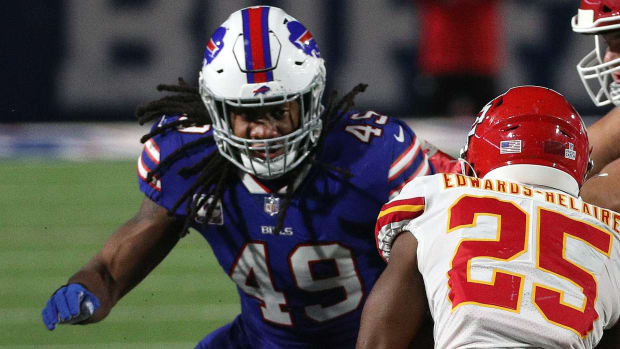
LB Matt Milano
Milano plays well in coverage, but quarterbacks still look his way three or four times a game. He still misses too many tackles with some growth pressuring the quarterback. Overall, his game lacks star power, and he only made 45 tackles over 10 games in 2020 (101 over 15 matchups in 2019). The Bills need more production out of this position this season if they want to improve on the defensive side of the ball.
LB A.J. Klein
Klein has been in the NFL for eight seasons, but he tends to struggle in all areas. His playing time increased over the last three years for the Saints, but he worked as a rotational player for the Bills in 2020. Klein set a career-high in tackles (75) and sacks (5) despite having no value defending the run.
DE Jerry Hughes
Over his last nine seasons, Hughes missed one game (2020). His upside rushing the quarterback continues to fade, and last year he played through two injuries (back and foot). A former first-round player (2010), but his career peaked in 2013 and 2014. His value against the run is no longer an asset, and Hughes misses too many tackles. Look for incoming rookie DE Carlos Basham to steal some of his snaps this year.
DE Gregory Rousseau
The Bills needed another pass rusher from the outside, and they placed their bet on Rousseau in the first round of the 2021 NFL Draft. At the very least, he brings speed, athletic ability, and youth to the outside of Buffalo’s offensive line.
DT Ed Oliver
Oliver lost momentum as a pass rusher in his second year in the NFL after getting drafted in the first round in 2019. His high motor should work well, but his aggressiveness and lack of size may be used against him on run plays. Last year he finished with three sacks and regression defending the run. Oliver has a lot to prove in 2021.
DT Vernon Butler
The Bills signed Butler to a two-year contract in the offseason for $16 million in 2020. He failed to pick up a sack last year while failing to gain momentum against the run. Butler is a former first-round draft selection (2016).
This defense could fall quickly to the bottom of the league if their two top players (Edmonds and White) don’t regain their form and Buffalo doesn’t figure out their problems on the defensive line. The Bills can’t pressure the quarterback up the middle, and they have issues defending the run.
From a fantasy perspective, I’d avoid rostering the Bills’ defense on draft day. If they show the ability to get after the quarterback, I could see playing them in some favorable matchups.



0 Comments:
Post a Comment